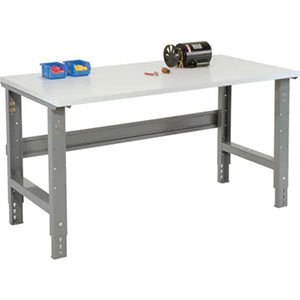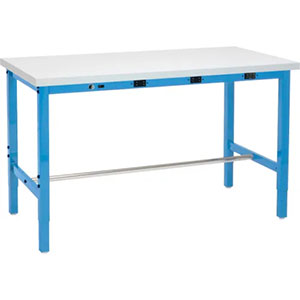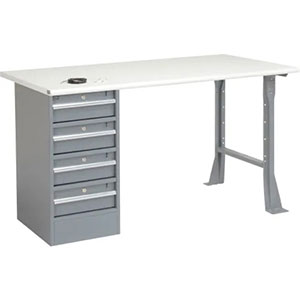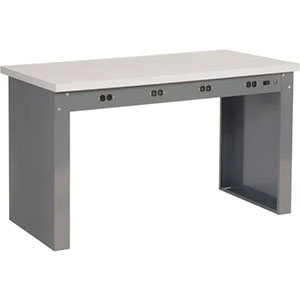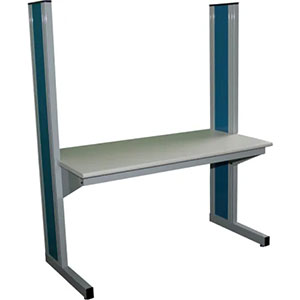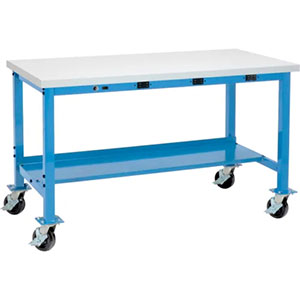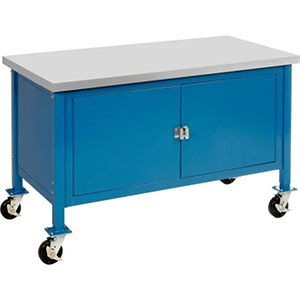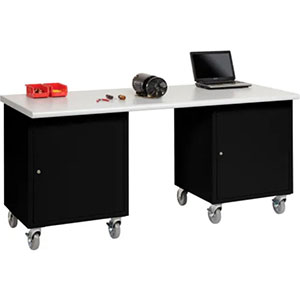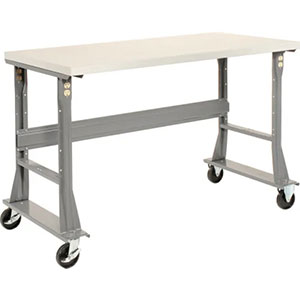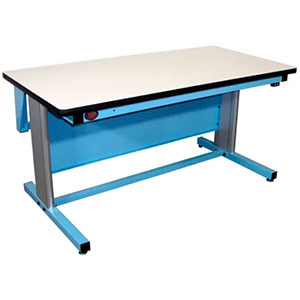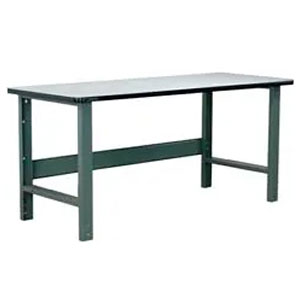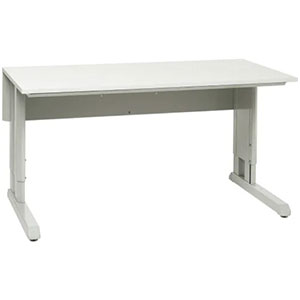If your work involves assembling, testing, or repairing electronics, you’re dealing with a silent threat every day. And that threat is electrostatic discharge (ESD). You can’t see it. You may not even feel it. But it can destroy the sensitive components that keep your business running. One small zap can lead to one big disaster. And that’s where an ESD workbench comes in.
So, What Is ESD, and Why Should You Care?
Electrostatic discharge (ESD) is the sudden flow of electricity between two objects with different electrical charges. It’s like that little shock you sometimes feel when touching a doorknob. But when you’re working with electronics, that same shock can silently fry microchips and circuits. Here’s how it happens:
- Rubbing materials together (like walking across a carpet or removing plastic packaging) builds up static electricity.
- If a charged person or object touches an electronic component, the built-up energy discharges into the device.
- That discharge can then damage or destroy delicate components, sometimes immediately, but it may not be apparent for weeks, or even months, down the line.
And the cost? It’s not small. According to the ESD Association, industry losses from ESD-related damage exceed $5 billion annually in the U.S. alone.
What are The Hidden Costs of Not Having an Electrostatic Discharge System?
For Equipment, it can be very costly and lose you valuable time:
- Immediate damage: Sensitive parts like microcontrollers, transistors, and memory chips can be instantly destroyed.
- Delayed defects: ESD can weaken a component without causing immediate failure, leading to long-term reliability issues or product returns.
- Production downtime: If ESD damage isn’t caught early, entire production runs may need to be reworked or even recalled.
When it comes to your employees, ESD isn’t usually dangerous to humans physically. However, a small shock can cause a startling reaction, especially if someone’s working with sharp tools, hot equipment, or in a busy environment. That momentary distraction can result in serious injury and damaged inventory.
Enter the ESD Workbench: Your First Line of Defense
An adjustable ESD workbench is more than just a place to work. It’s a fully engineered electrostatic discharge system that prevents static buildup and safely dissipates charges.
What are the benefits of an ESD workbench?
- Control static electricity with grounded, static-dissipative surfaces.
- Give your components the electrostatic discharge protection they need.
- Improve workflow with ergonomic, customizable configurations.
- Support productivity by keeping your team safe and comfortables.
What Makes Industrial ESD Workbenches Safe?
Not all ESD workbenches are created equal. To be considered ESD-safe, a workbench must be built with the right materials and components that meet the standards for ESD protection for electronics.
Why should your facility use anti-static workstations?
- Static dissipative surface: A grounded top layer that bleeds off static charge safely and quickly.
- Surface resistance: Typically between 10⁶ to 10⁹ Ohms, ideal for controlling discharge.
- Discharge rate: The ability to dissipate a 5,000-volt charge in as little as 0.01 seconds.
- Grounding points: For wrist straps, heel grounders, and other ESD accessories.
- Conductive frame and components: This includes legs, shelving, and drawers, all properly bonded and grounded.
Ergonomic Design Matters, Too.
While ESD protection is critical, a good adjustable ESD workbench is also ergonomically designed for repetitive, high-precision tasks. The goal? To reduce fatigue, increase efficiency, and protect workers from long-term injury. Features like adjustable heights, anti-static materials for electronics, angled shelves, and footrests allow workers to customize their environment for the very best comfort and focus possible. And over time, these small details add up to higher job satisfaction and better output. An electrostatic discharge device really does pay for itself over time.
How to Choose the Best Workbench for ESD Protection
Not sure where to start? The first decision is whether you need a stationary or mobile setup. From there, consider your workspace layout, the type of electronics you handle, and the specific workflow needs of your team.
What are the main types of ESD workbenches?
Stationary ESD Workbenches
Stationary ESD workbenches provide a durable, static-safe workspace designed to protect sensitive electronic components from electrostatic discharge. With sturdy construction and a range of configurations, they offer reliable performance for assembly, testing, and repair tasks in labs, production lines, and technical environments.
What kinds of stationary ESD workbenches are available?
Adjustable Height Workbench
This versatile ESD-safe bench comes with height-adjustable legs, allowing your crew to customize the working surface to their ideal conditions. This is best suited to workplaces where workers of different heights share the same workspace, or for alternating between sitting and standing tasks.
Heavy Duty Adjustable Height Workbench
Built to handle heavier equipment and workloads, this ESD work surface combines ergonomic adjustability with enhanced weight capacity. Featuring reinforced construction, it maintains stability and ESD protection even under demanding conditions. This kind of bench is perfect for industrial electronics assembly or repair environments with bulky tools or components.
Pedestal Workbench
This ESD workbench has pedestal storage on one or both sides, providing drawers or cabinets beneath the work surface for tools, components, and supplies. This is a great bench for workspaces where organization and accessibility are critical.
L-Shaped Adjustable Height Workbench
The L-shaped configuration of this desk makes the best use of corner workspaces, while remaining height-adjustable for ergonomic use. Perfect for technicians who need multiple work zones or to fit into corner areas efficiently.
Panel Leg Workbench with Power
Supported by panel-style legs, this ESD bench comes with integrated power outlets and wiring channels. This design allows easy access to electricity for tools and testing equipment, keeping cords organized and minimizing trip hazards.
Fixed Leg Workbench
A simple, reliable ESD workbench with fixed-height legs. Designed for stability and durability, this option is ideal for consistent, high-traffic workstations where adjustability is not required. It offers a cost-effective ESD solution for many assembly and inspection tasks.
Security Cabinet Workbench
An ESD bench with lockable cabinets built into its structure provides secure storage of tools, components, or even sensitive materials. Perfect for environments where security and access control are critical.
Modular Workbench with Electric Circuit System
A highly adaptable, ESD-protected workbench that incorporates modular components and an integrated electric circuit system. This enables easy configuration of storage, lighting, and power distribution, making it ideal for labs and production lines that continue to evolve.
Mobile ESD Workbenches
Mobile ESD workbenches combine static-safe protection with the flexibility to move your workspace wherever it’s needed. Designed with sturdy casters and durable construction, they allow technicians to transport tools, components, and sensitive electronics safely across production floors, labs, or repair areas.
What kinds of mobile ESD workbenches are available?
Mobile Production Workbench
An ESD-safe workbench designed for mobility, with heavy-duty casters allowing it to move between stations or production lines. It also features locking wheels for stability when in use.
Adjustable Height Workbench
This mobile ESD bench combines the flexibility of height adjustability with portability. Workers can move it to wherever it’s needed and adjust the surface height to maintain.
Cabinet Workbench
A mobile ESD-safe bench with built-in cabinets or drawers, offering secure and organized storage that can travel with the operator. Perfect for technicians who need to bring their tools and parts with them.
Pedestal Workbench
Similar to the stationary version but on wheels, this mobile ESD workbench includes pedestal storage and a stable, rolling platform. It gives your employees excellent organization for a variety of tools and components.
Flared-leg Workbenches
A distinctive mobile ESD bench featuring flare-style legs for better stability and maneuverability. Designed for work spaces where ease of access under the bench is important.
Trusted Brands That Deliver
At Global Industrial, we carry top-performing ESD workbench brands that meet the most rigorous standards. Our top brands to consider are:
But before you hit “buy,” make sure you’ve considered the following:
- Workspace size: Will the bench fit with room for your team to work comfortably?
- Weight capacity: Do you need to support heavy monitors, tools, or parts bins?
- Grounding needs: Will you need additional grounding kits, wrist straps, or mats?
- Add-ons: Lighting, shelving, storage, power strips, and monitor arms can enhance usability.
And if you need more help choosing, check out our Ultimate Workbench Buying Guide for a deep dive into sizing, styles, and features.
ESD Workbenches: The Bottom Line
If your work touches electronics, ESD isn’t optional; it’s a risk that needs managing. An ESD workbench is the most effective, ergonomic, and cost-efficient way to protect both your technology and your team. They’re not just work surfaces, they’re smart investments that:
- Prevent costly failures.
- Keep your production on track.
- Protect employee well-being and morale.
- Improve your facility’s compliance and safety.
So, whether you’re upgrading an existing station or designing a new workspace from scratch, start with the bench and build out from there. Explore our full range of ESD workbenches and see how the right setup can transform the way you work. And if you need any help selecting the ideal ESD workbench, one of our experts will be happy to help you find the perfect fit for your facility.
The information contained in this article is for informational, educational, and promotional purposes only and is based on information available as of the initial date of publication. It is the reader’s responsibility to ensure compliance with all applicable laws, rules, codes, and regulations. If there is any question or doubt in regard to any element contained in this article, please consult a licensed professional. Under no circumstances will Global Industrial® be liable for any loss or damage caused by your reliance on this article.
